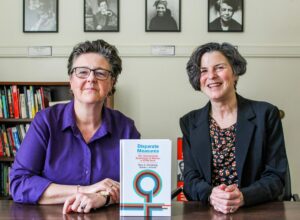Disparate Measures: The Intersectional Economics of Women in STEM work (2024) (joint with Mary Armstrong)
An exploration of workplace participation and earnings patterns for diverse women in US STEM professions that upends the myth that STEM work benefits women economically.
Seen as part economic driver, part social remedy, STEM work is commonly understood to benefit both the US economy and people—particularly women—from underrepresented groups. But what do diverse women find when they work in US STEM occupations? What do STEM jobs really deliver—and for whom? In Disparate Measures, Mary Armstrong and Susan Averett challenge the conventional wisdom that a diverse US STEM workforce will bring about economic abundance for the women who participate in it. Combining intersectionality theory and critical data theory with a feminist economic analysis, the authors explore how different groups of diverse women truly fare in US STEM professions.
Disparate Measures is centered on eight unique, in-depth case studies, each of which provides an intersectional economic analysis (a term coined by the authors) of diverse women working in STEM occupations. Four case studies prioritize women of color and examine the STEM participation and earnings of Black women, American Indian and Alaska Native women, Asian and Pacific Islander women, and Hispanic women/Latinas; four additional case studies illuminate intersections that are frequently neglected by the STEM inclusivity literature: foreign-born women, women with disabilities, Queer women, and mothers. What the authors find in their groundbreaking, detailed analysis is that the promises of STEM are only partly true: when compared to women not working in STEM, most women are indeed economically elevated by STEM occupations—yet when compared to white men in the same STEM occupations, women’s second-class status is usually reaffirmed. The authors conclude by offering seven “big-picture” recommendations for rethinking STEM equity, showing just how we can successfully confront the entrenched patterns of economic disadvantage faced by diverse women in STEM jobs.

(Mary Armstrong (left), Susan Averett (right)
Photo courtesy of Austin Carey
Women in the Workforce: What Everyone Needs to Know (2022) (joint with Laura M. Argys)
- An accessible overview of the power of women in the economy and the obstacles they faceWomen are joining the workforce in increasing numbers, making inroads as entrepreneurs and leaders, acquiring more education, marrying later, and having fewer children – all trends consistent with spending a far greater fraction of their adult lives in the labor force. And yet, even as women break the glass ceiling and challenge gender and sexual norms, they are told they need to “lean in” and powerful movements like #TimesUP and #MeToo are still necessary to expose and overcome endemic discrimination, exploitation, harassment, and worse.Women in the Workforce: What Everyone Needs to Know ® provides an essential and accessible introduction to the significance of women in the economy and the obstacles they face in claiming equal status. Economists Laura M. Argys and Susan L. Averett tackle timely topics like the wage gap, “women’s work,” and gendered workplace interactions in an easy-to-read question and answer format. The book focuses on the choices people make and how these are framed by institutional impediments that create inequalities in the options available to men and women. Argys and Averett highlight how the experience of being a woman in the labor market varies, sometimes dramatically, by race, ethnicity, sexual orientation, and socioeconomic status. They also explore how living in cities, towns, and rural areas influence choices and outcomes.Covering a range of topics, from breastfeeding and work, earnings penalties for women who have taken time away from work, and childcare while women work, to the gender pay gap and the distinctive challenges women face as they age and transition to retirement, this book answers the essential questions surrounding women in the workforce.
The Oxford Handbook of Women and the Economy (published 2018)
Abstract
The transformation of women’s lives in the past century is among the most significant and far-reaching social and economic phenomena, affecting not only women, but also their partners and children. This Handbook provides the first comprehensive collection of essays that addresses these issues, using the powerful framework of economics. The essays are divided into three broad sections—marriage and fertility; the labor market; and special topics and policy issues. Separate and special attention is given to developed and developing economies, because the constraints women face and the key policy issues vary by level of development. While the primary focus is economics, where appropriate, the essays incorporate the newest interdisciplinary research about gender from biology and other disciplines. These essays will be of value to a wide range of readers, from specialists to students, and also to scholars in other disciplines seeking an overview of the most current research approaches and findings in economics
Why Gender Matters so much in Policymaking blog post written for Oxford University Press with Laura Argys and Saul Hoffman
Women in the Economy: Family Work and Pay (fourth edition,2021) Textbook with Saul D. Hoffman
(fifth edition coming in early 2025)
Description:
This textbook presents a comprehensive economic analysis of women’s issues and the economic factors that have changed their lives, from marriage and fertility to work and pay. Hoffman and Averett examine topics such as gender wage differentials, changes in marriage markets and fertility, and the rise of women’s labour force activity. It also includes coverage of a wide range of policy issues, from taxes to family policy to microlending. Examples are combined with formal analysis, to give students a firm understanding of this area of economics.
This textbook will be invaluable for undergraduate and postgraduate students of economics, development and women’s studies. The level of economic analysis is suitable for students with basic economics knowledge.
